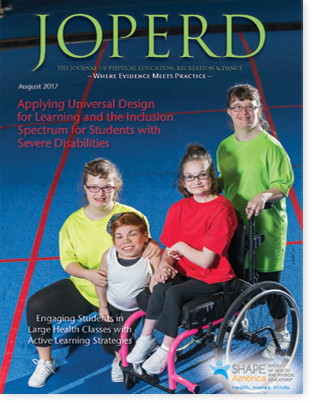 JOPERD Table of Contents
JOPERD Table of Contents
Classroom to Community: Field Studies for Exercise Science Students
Deana Melton & Teresa K. Dail

Kinesiology, the scientific study of human movement, is a field that developed over the years from the physical education profession (Hoff man, 2013). The discipline now includes a number of highly specialized subdisciplines, such as exercise physiology, motor learning, biomechanics, sport and exercise psychology, sport and fitness management, and sport history. Some undergraduate kinesiology students may find it easy to choose their particular concentration and to know the specific area they would like to study (e.g., pre-physical therapy, sport management, pedagogy). However, other kinesiology students, such as those in departments of exercise and sport science, may choose a subdiscipline simply because they are interested in the general area of health and fitness. In fact, it is common for exercise science students to reach senior year and still not know which areas within the discipline might best align with their career objectives (Hoffman, 2013).
The issue of career choice has been studied through social cognitive career theory (Lent Brown, & Hackett, 1994). This theory establishes three constructs — self-efficacy, outcome expectations and choice goals — and explores how those constructs interact with environmental factors to correlate with the choices people make. Research suggests that environmental supports are key in assisting sport and leisure studies students in determining their career selection (Cunningham, Bruening, Sartore, Sagas, & Fink, 2005). Part of providing this support involves faculty guidance to help students determine their interest in specific concentrations, since interest is closely aligned with the ability to establish choice goals (Cunningham et al., 2005).
The large number of choices in kinesiology stems from the fact that a broad group of courses underlie the field: sports management, athletic training and sports medicine, sociocultural analyses of sports, sport and exercise psychology, fitness leadership, and physical education teacher education. In addition, there is preprofessional training available for allied health careers, such as in physical therapy and occupational therapy (American Kinesiology Association, 2015). Being able to more clearly understand these various subdisciplines and to connect academic content with the workplace can greatly help students in making better decisions regarding their career choice. One way to gain knowledge of the subdisciplines is through rigorous content preparation in the classroom. However, connecting this content to employment or further schooling can arguably and most logically occur in an applied setting. We see this most often in the internship or capstone experience, which is typically a semester-long experience in students’ the senior year.
Capstone internships can be very rewarding for students, allowing for integration of what was learned in the classroom throughout their plan of study. However, these internships typically range from 150 to 400 hours. For students who are still not sure which areas are of most interest, this is an inordinate amount of time to spend in one facility, particularly if students realize early on in the experience that the site they chose is not relevant to them. To give students additional experience in the workplace, students in concentrations such as sports management and pre-allied health typically have a shorter field experience (40 hours or fewer) as a separate course in management or clinical settings. For accreditation purposes, as well as additional experience, some authors recommend service-learning (community) experiences specifically for physical education teacher education candidates (Cervantes & Meaney; 2013; Everhart, 2014). However, for students who are in broader concentrations such as exercise science and fitness leadership, one extra field experience course may not be enough to help determine which area interests them. In order to address the issue of helping students determine their interest areas, some authors have suggested pre-internship experiences that involve on-campus activities (e.g., assisting with conducting fitness assessments, teaching group exercise classes, coordinating health fairs; Campbell & Kovar, 1994). However, the authors of this article would like to recommend the field study, a different type of experience for kinesiology students who have not yet determined a definite career direction. The purpose of this article, therefore, is twofold: (1) to establish a case for the inclusion of field studies earlier in exercise science curricula, and (2) to offer a step-by-step process for its implementation.
To read the rest of this article,
click here to download a pdf.